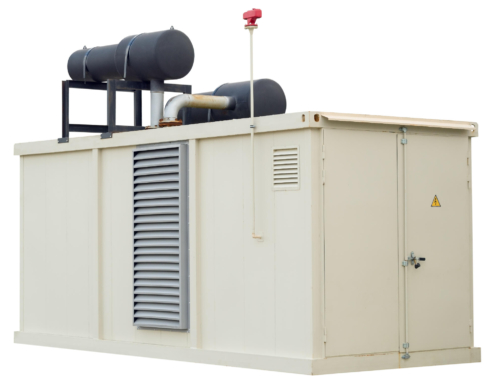Even if you are using your used diesel generator for backup or emergency power, it is important that you know your machine is in good, working condition. If your standby generator doesn’t work as expected during a power failure or during times of work, this can mean detrimental consequences for you, your employees, or your company. This is why you should incorporate load bank testing into the upkeep of your used standby generators.
Table of Contents
What is Load Bank Testing Process?
Load bank testing is a procedure that is used to evaluate the state of your generator, ensuring that it is in prime condition to work under different types of loads. It is common practice to regularly test your generators to ensure that they remain at their peak performance.
Generator load bank testing is done by placing an artificial, or “dummy” load, on the Genset. This way of testing, without using a real load, helps protect other machines, appliances, and the system the generator is connected to, should the used diesel generator that is being tested turn out to be faulty or dangerous. the artificial generator load also ensures that the people conducting the generator load bank test stay safe.
The artificial load is steadily increased, and the activity within the generator’s engine and alternator, along with critical engine parameters such as oil pressure, engine temperature, fuel pressure, etc. are recorded continuously. After the test, these generator output readings are assessed to ensure the safety of the equipment and the overall generator’s ability.
Most generator owners consider load banks to be a great way to measure fuel consumption. Load banks can show you if your used diesel generator is efficiently using diesel fuel. If you notice your generator is not properly consuming fuel, this could be because of wet-stacking, which is when grease, oil, and fuel build up and makes your used diesel generator less efficient. In this case, extensive generator maintenance proves to be the right way to go!
The good news is that the only equipment you need to run a load bank test (other than a generator) is the load bank itself.
Did you Know?
Load Bank Testing is mandated by the National Fire Protection Association (NFPA) for buildings and facilities with emergency or standby power systems!
Types of Load Banks
There are four different types of load banks that are used during load bank testing of emergency generator sets, and each has its own benefits or pitfalls, depending on your needs. You can purchase a permanent load bank, or choose to rent a load bank. This can be a more cost-efficient option.
Reactive Load Banks
Reactive load banks are typically best suited when load testing vehicles and transformers, like ones that are used in telecommunications or UPS industries.
Reactive load bank test loads that involve inductors or capacitors within the load. It works by converting electric energy within a magnetic field. You will see inductive loads more often than capacitive loads, as the inductive load bank only tests up to 75% of a load’s full power, while capacitive load tests up to 100% of the load.
Resistive Load Banks
This type of load bank makes it possible to test a generator and a prime mover at 100% load capacity, which is the most effective capacity to test your generator at. Resistive load banks allow you to easily measure loads, as the electrical energy that is produced translates into heat via the resistors, and the heat is filtered out through air or water.
Resistive loads are also the most similar to the loads your used diesel generator will encounter during everyday work, as it stimulates the prime mover capacity, controls, and transient response. However, resistive load banks are not the most efficient when measuring the alternator capacity and controls, load-sharing controls, distribution bus, and transient response.
There are many types of resistive load banks that come in a multitude of sizes and power. Your choice of resistive load bank will depend on your needs.
Resistive load banks are best for smaller generators that have a capacity under 200 kVA.
Resistive & Reactive Combination Load Banks
As the name suggests, combined resistive and reactive load banks use methods from resistive load banks in combination with those from reactive load banks, in order to form a more complete test for your used diesel generator. These load banks can test a multitude of factors, such as prime mover capacity and controls, alternator capacity and controls, load-sharing controls, distribution bus, and transient response.
Resistive & reactive combination load banks are most optimal when testing generators with a power capacity greater than 200 kVA or 1 MVA, or multiple generators working on the same system.
Electronic Load Banks
Electronic load bank test work by placing an artificial load on your used diesel generator. Of all the types of load banks on this list, electronic load banks typically provide the most accurate data in comparison to resistive, reactive, or resistive/reactive combination load banks.
That being said, electronic load banks are often more pricey than their alternatives. However, they are well worth it because electronic load banks are also entirely customizable, as you can program them to fit any type or size of the generator.
Our Take
Overall, load bank testing helps ensure that your engine is in good condition for your needs and does not pose any dangers to you or your employees. In short, your backup power source can ensure reliable operation during an emergency situation.
If you have any questions about load banks or purchasing a used diesel generator, give our industry professionals at Swift Equipment Solutions a call at +1-713-561-5916 or email us at sales@swiftequipment.com.
Frequently Asked Questions (FAQs) About Generator Load Bank Testing
Why do I need a proper load bank test?
By using artificial loads to test the efficiency of a generator, load bank testing ensures that the generator is functioning efficiently and that it is not broken during a time of emergency! Additionally, it can help you address any wet stacking or fuel pressure issues your generator may be having in order to have it repaired or serviced.
What is the best type of load bank to get for my used diesel generator?
Though they are typically more expensive, an electric load bank is the best type of load bank because it can give you more accurate data about how your used diesel generator is functioning. It is also best for multiple generators running on the same system. It is possible to buy electric load banks used for a lower price.
What does it mean when my used diesel generator isn’t properly consuming fuel?
If your used diesel generator is not as fuel-efficient as it once was, this could be because of something called wet-stacking. Wet-stacking occurs over time when fuel, oil, and grease build up on the engine which makes it difficult for the generator to function correctly, leading to inefficient fuel consumption.






![How to Calculate the Efficiency of a Diesel Generator [With Formula]](https://swiftequipment.com/wp-content/uploads/2023/04/diesel-generator-500x383.jpeg)
Leave A Comment